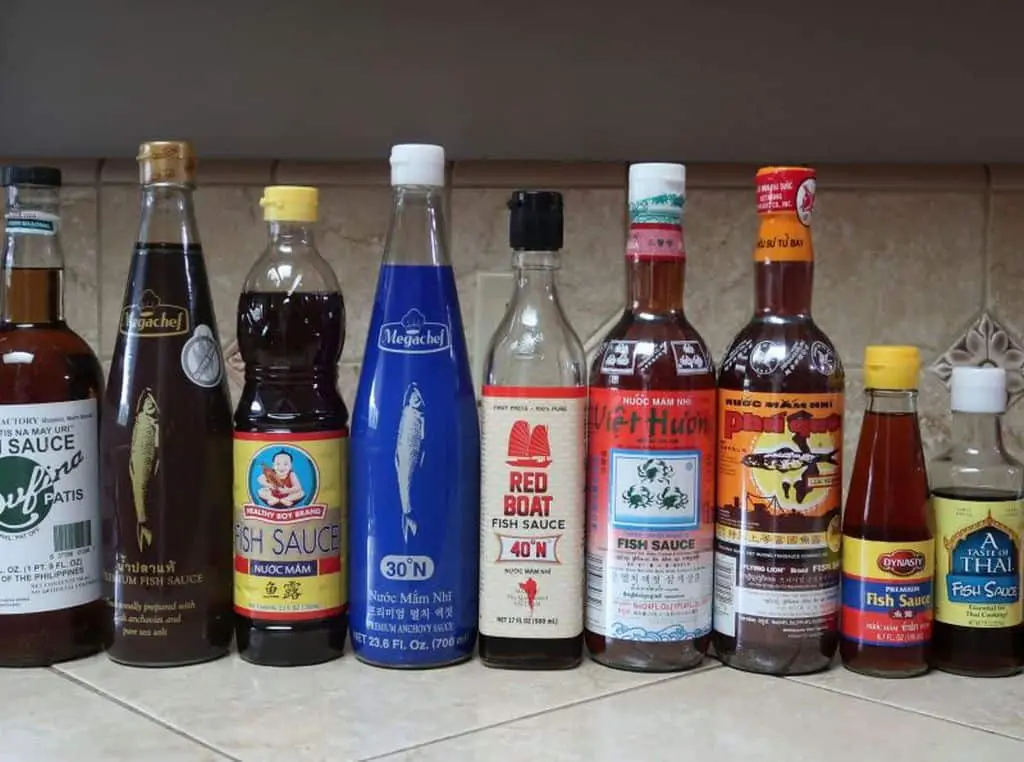Does Fish Sauce Have Shellfish? Unveiling the Allergen Truth!

Are you a fan of the tantalizing flavors of Asian cuisine? If so, you’re likely familiar with the magical elixir known as fish sauce. Its umami-rich taste and unmistakable aroma have the power to transport your taste buds to new culinary heights. But if you have a shellfish allergy, a lingering question may linger in your mind: Does fish sauce contain shellfish?
It’s time to uncover the truth behind this allergen concern and put your worries to rest. In this article, we’ll delve deep into the world of fish sauce, exploring its origins and ingredients. We will find the answer to the question surrounding its allergenic properties.
Get ready to separate fact from fiction as we demystify the hidden secrets of fish sauce. We shed light on whether it poses a risk to shellfish allergy sufferers. So, grab a seat at the table as we embark on a flavorful journey to unravel the truth about fish sauce and its potential allergens.
Understanding Fish Sauce
Fish sauce is a staple ingredient in many cuisines around the world and is renowned for its umami flavor and distinctive aroma. It is used in Asian cooking, particularly in dishes from Thailand, Vietnam, and Cambodia.
To begin our exploration, let’s first understand what fish sauce is and how it’s made. Fish sauce is a condiment derived from fermented fish, often with the addition of salt.
The typical method of making fish sauce involves layering salt and fresh fish in sizable vats. Then allow the mixture to ferment for several months. Fish or shellfish enzymes break down proteins to create fish sauce, which is strained and bottled.
Does Fish Sauce Have Shellfish?

Fish sauce, despite its name, does not typically contain shellfish. The traditional method of making fish sauce involves salting and fermenting fish, usually anchovies or other small fish. The process involves placing the fish in salt and allowing them to ferment for several months. During fermentation, the fish break down, releasing their flavors into the liquid, which is then strained to get the fish sauce.
While fish sauce is derived from fish, it does not usually include shellfish as an ingredient. However, the production process and ingredients can vary among different brands and types of fish sauce. Some commercial fish sauces may use a combination of fish and shellfish. They may include shellfish extracts as flavor enhancers.
Thus, if you have shellfish allergies or dietary restrictions, pay attention! You should read the label and verify the ingredients of the specific brand of fish sauce you intend to use.
For individuals with shellfish allergies, there are alternative options available. Vegan fish sauce substitutes are available on the market. This product is typically made from ingredients like soy sauce, mushrooms, seaweed, or other plant-based seasonings. These alternatives aim to replicate the umami flavor profile of fish sauce without using fish or shellfish.
WARNING
For accurate information about specific brands or products, contact the manufacturer of fish sauce. You also need to contact a healthcare professional if you have shellfish allergies or dietary restrictions.
Fish Sauce Varieties
To better understand the presence of shellfish in fish sauce, let’s examine some popular varieties and their ingredients. Please note that the information provided here is general and may vary among different brands and manufacturers.
Traditional Fish Sauce
The traditional fish sauce, often associated with Southeast Asian cuisines, is typically made exclusively from fish without the inclusion of shellfish. Brands like Thai fish sauce, Vietnamese fish sauce, and Filipino fish sauce adhere to the traditional method of fish sauce production. These brands are focusing solely on fish as the primary ingredient. Therefore, if you have a shellfish allergy, traditional fish sauce should generally be safe for consumption.
Modern Variations
Some manufacturers have introduced fish-and-shellfish fish sauces in recent years. These variations aim to enhance the flavor complexity and depth of the sauce.
Read the labels carefully or contact the manufacturer directly to determine if shellfish is present in the specific brand or product you intend to use. By doing so, individuals with shellfish allergies can avoid any potential adverse reactions.
Cross-Contamination Concerns
While the ingredients listed on the fish sauce bottle provide valuable information, you just won’t stop there. Be aware of potential cross-contamination risks during production. If a manufacturing facility processes both fish and shellfish products, there is a possibility of cross-contamination. This is where trace amounts of shellfish proteins could find their way into fish sauce, even if shellfish is not intentionally included in the recipe.
To minimize the risk of cross-contamination, reputable manufacturers implement stringent quality control measures and adhere to strict cleaning protocols. Many brands also label their products with allergen information to warn of cross-contamination.
By reviewing this information and choosing products from trusted sources, shellfish allergy sufferers can reduce allergen exposure.
For you as a consumer, it is important to store fish sauce separately from shellfish or shellfish-containing ingredients. Use clean utensils and surfaces when handling fish sauce to avoid any potential contamination. Following this method, you can prevent fish sauce and shellfish cross-contamination in your household.
Safe Alternatives for Shellfish Allergies
If you have a shellfish allergy or prefer to avoid fish sauce altogether, you can still enjoy the same sauces. There are several alternatives available that can provide similar flavor profiles in your culinary endeavors. Here are a few options worth considering:
- Soy Sauce: This popular condiment made from fermented soybeans offers a rich umami taste that can serve as a substitute for fish sauce in many recipes.
- Tamari: Similar to soy sauce, tamari is a gluten-free alternative that is also derived from fermented soybeans. It has a slightly milder flavor compared to traditional soy sauce but can still add depth to your dishes.
- Coconut Aminos: Made from the sap of coconut blossoms, coconut aminos is a soy-free and gluten-free option that provides a sweet and savory taste. It closely resembles the flavor profile of fish sauce and can be an excellent substitute in various recipes.
- Mushroom Sauce: Mushroom sauce, particularly those made from shiitake mushrooms, can offer a rich, earthy flavor similar to fish sauce. It can be a suitable replacement for fish sauce in vegetarian or vegan dishes.
- Anchovy-Free Fish Sauce: Some brands now offer anchovy-free fish sauce options, which can be a great alternative for those who have a shellfish allergy but can tolerate fish. These fish sauces are made solely from fish, without the inclusion of shellfish.
INFO
Tips for Choosing and Using Fish Sauce
For those who can consume fish sauce without any concerns, here are some helpful tips for selecting and using fish sauce in your culinary endeavors:
- Check the ingredients: Before purchasing a fish sauce, read the label to ensure that it contains the desired ingredients and does not include any allergens or additives that you wish to avoid.
- Quality Matters: Choose high-quality fish sauce from reputable brands. These may be slightly pricier but offer better flavor and are more likely to follow strict manufacturing practices.
- Start with Small Amounts: Fish sauce is potent and can easily overpower a dish if used in excess. Start with a small amount and gradually add more, tasting as you go, to achieve the desired flavor.
- Store Properly: Fish sauce should be stored in a cool, dark place, away from direct sunlight. Refrigeration fish sauce is not necessary but can help extend its shelf life.
- Experiment and Enjoy: Fish sauce is a versatile ingredient that can elevate the flavors of various dishes. Don’t be afraid to experiment with different recipes and cuisines to fully explore its potential.
Fish Sauce Brands That Are Specifically Labeled as Shellfish-Free
Here are some fish sauce brands that are specifically labeled as shellfish-free:
- Red Boat Fish Sauce: Red Boat Fish Sauce is shellfish-free and made from wild-caught black anchovy and sea salt. They have several products that are shellfish-free, including their Premium Fish Sauce, Chef’s Grade Fish Sauce, and 40°N Fish Sauce.
- Thai Kitchen Premium Fish Sauce: Thai Kitchen’s Premium Fish Sauce is gluten-free and shellfish-free. It is made from the pressing of salted anchovies and provides an essential savory flavor found in traditional Thai cuisine.
- A Taste of Thai Fish Sauce: A Taste of Thai’s Fish Sauce is gluten-free and shellfish-free. It is made from anchovy extract, salt, and sugar.
- Ocean’s Halo Vegan Fish Sauce: Ocean’s Halo’s Vegan Fish Sauce is gluten-free and shellfish-free. It is made from seaweed, soy sauce, and other natural ingredients.
It is important to note that while these brands are labeled as shellfish-free, always double-check the ingredient list. If in doubt, contact the manufacturer if you have any concerns about allergens.
Final Thoughts
In conclusion, while fish sauce traditionally does not contain shellfish, you must be aware of variations and potential cross-contamination risks. For individuals with shellfish allergies, it is crucial to carefully read labels, contact manufacturers if needed, and consider alternative condiments that suit their dietary restrictions.
By making informed choices, everyone can enjoy the unique flavors and culinary delights that fish sauce brings to the table.
FAQs
Is fish sauce safe for people with shellfish allergies?
Fish sauce is generally safe for individuals with shellfish allergies since it is primarily made from fish. However, you need to read labels and check for any potential cross-contamination or undisclosed ingredients.
Can fish sauce contain trace amounts of shellfish allergens?
Shellfish allergens may be present in fish sauce, even though production methods reduce the risk. Individuals with severe shellfish allergies should exercise caution and consult with their healthcare provider.
How can I determine if a fish sauce product is free from shellfish?
To determine if a fish sauce product is shellfish-free, carefully read the ingredient label. Look for any indication of shellfish or shellfish-derived ingredients. If uncertain, it is advisable to reach out to the manufacturer for clarification.
Where can I find reliable information and resources about fish and shellfish allergies in relation to food products like fish sauce?
Healthcare professionals, allergists, and reputable medical websites can provide information about allergies, including fish and shellfish allergies. These sources can provide accurate and up-to-date information to help you make informed decisions about your dietary choices and allergen management.





